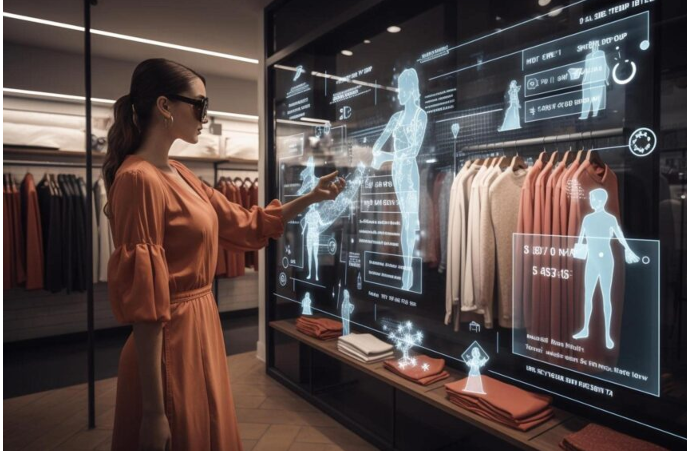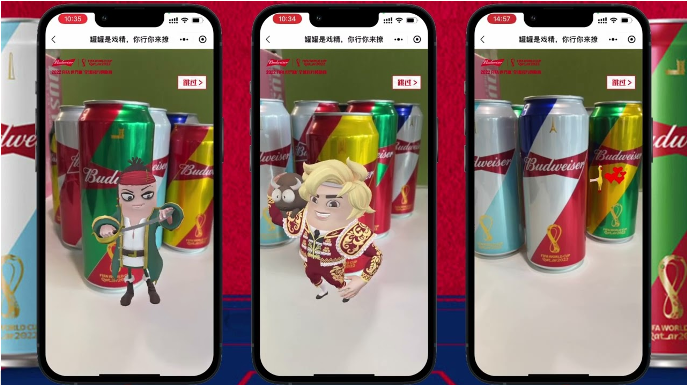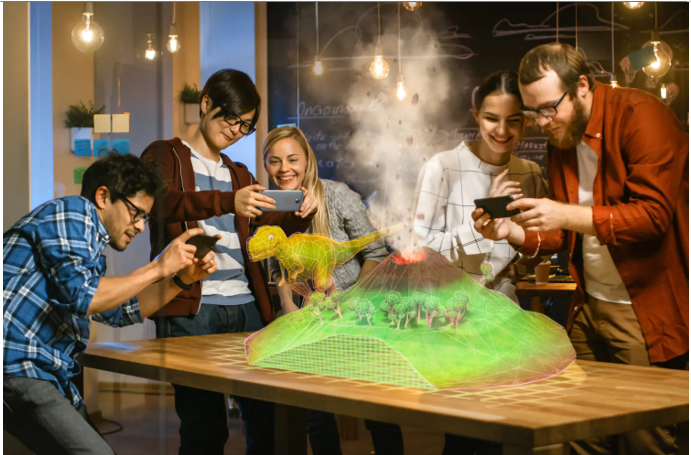What are AR and AI: Understanding the basics
Augmented reality and artificial intelligence are two innovative technologies that are reshaping and enhancing how humans interact with physical and digital worlds. Both technologies coordinate behind the scenes to create the magic of engaging and immersive experiences.
Augmented reality technology works by overlaying digital elements in real-world scenarios. This allows users to interact with virtual elements in a real environment, creating immersive experiences. On the other hand, artificial intelligence works by mimicking human-like intelligence to analyze data, make predictions, solve problems, and offer solutions.
Importance of integrating AR with AI: How both technologies work together?
When AI and AR come together, they have the potential to completely transform how we experience, perceive, and engage with digital content by making it more personalized and interactive. AI enhances the AR experience by using deep neural networks to improve traditional computer vision methods. This allows AR applications to incorporate advanced features like object detection, text analysis, and scene labeling.
AI-powered chatbots make AR applications more interactive through natural language processing. AI algorithms provide real time analysis of user’s actions, preferences, and behaviors. This helps AR chatbots to offer personalized suggestions and responses to users.
This combination of AI’s intelligence capabilities and AR’s immersive and interactive visuals creates exciting applications for e-commerce brands to enhance user experiences in AR try-ons, virtual shopping, training simulations, and product marketing.
For example, Kivisense offers innovative AR, VR, and AI based solutions for many leading fashion brands including Gucci, Tiffany, Tommy Hilfiger, Dior, and Burberry. We offer AR and AI-powered virtual try-ons for clothes, jewelry, shoes, watches, bags, and other fashion accessories. This helps customers view how a certain fashion product will look on them before buying it, which leads to increased brand engagement and conversion rates.
Key technologies behind Augmented reality AI
Computer vision
Computer vision is a subfield of AI that allows machines to interpret and understand visual data in real time. In augmented reality, it helps create immersive experiences through object detection, object tracking, and SLAM technology (simultaneous localization and mapping).
These technologies help system to recognize and identify objects in a visual frame precisely. Moreover, marker-based tracking analyzes and tracks movements of objects and users and counts them. SLAM technology creates accurate 3D maps of environment by tracking device’s location.
For example, Burberry offers immersive AR bag placement using AR and AI techniques. Computer vision technology interprets and analyzes user environment and enhances the bag visualization process. AR lets users virtually place the bag in their own space while AI algorithms allow them to interact with it by opening and closing it, and analyze its features in 3D. In this way, the combination of AR and AI gives a hyper realistic display of bag and lets users explore it as they would do in real world settings.
Depth tracking
Accurate tracking and spatial mapping enhance AR experiences by making them more immersive and interactive. This helps in analyzing an object’s location, shape, and orientation in a three-dimensional space. This is specially important in AR placement of furniture where depth tracking ensures that the furniture item appears at the correct size and distance from other furniture.
Moreover, depth sensors provide gesture recognition which lets users interact with AR content through hand movements. This provides realistic interactions and occlusion effects, making the AR experience highly engaging and immersive.
For example, Kivicube SLAM AR is web-based augmented reality solution that helps users select furniture from an online database and place it virtually in their desired location using their smartphone. AI algorithms can track the depth of user’s space through spatial mapping. This helps users figure out where the furniture model will fit and appear best, making their decision-making process easier.
Natural language processing
This AI-driven technology focuses on enhancing human-machine interaction by helping computers understand and respond to human language in a natural way. NLP helps AR apps to interpret voice commands of users and respond to them accordingly. This makes human interaction with digital content more realistic and intuitive.
Moreover, customers can use voice commands to trigger specific AR visualizations. For example, users can command a system to show how a certain dress or fashion accessory will look on them. AI-powered augmented reality systems will analyze and understand the command to provide users with their desired visuals.
3D modeling and rendering
This involves generating 3D models of objects and then creating 2D images from those models. AI can automate complex 3D modeling and rendering processes to generate high-quality visuals efficiently. On the other hand, AR can provide a real-time visualization of 3D models and renderings. Combining generative AI with AR can make 3D models appear more realistic by making them interactive, personalized, and engaging.
For example, Tiffany provides a hyper realistic jewelry shopping experience using AR, AI and 3D modeling and rendering. 3D technology creates lifelike 3D renderings of products like rings, necklaces, bracelets, and earrings. AR and AI allow users to virtually visualize these realistic renderings and interact with them in real time. AI-driven zoom feature help them to view the product features and details with in-depth clarity.
Industry applications of AI and AR Working together
Enhanced fashion and retail experience

Source: technology-innovators
Fashion and retail sectors are gaining a lot by integrating AI with AR. AR provides virtual try-on experiences for various fashion products like clothes, jewelry, shoes, and other accessories. In a virtual try-on, customers can visualize their desired looks and products on them virtually, which makes their shopping experience more interactive and exciting.
AI algorithms can analyze user data to determine user preferences, behaviors, and previous shopping patterns. These details can be useful in providing personalized product suggestions and try-on experiences. Combining AR with AI makes retail experiences more engaging and boosts customer satisfaction and brand sales. Kivisense offers AI-powered virtual try-ons for fashion and retail sectors, where users can not only try-out fashion elements but also interact with them through advanced AI and AR techniques.
Interactive marketing campaigns
Augmented reality and artificial intelligence help businesses and e-commerce brands advertise and showcase their products through interactive marketing campaigns. These innovative and sophisticated technologies allow brands to share their stories and heritage through engaging and customized experiences.

For example, Budweiser launched an incredible campaign for World Cup in 2022. The campaign featured FIFA special edition beer bottles representing eight countries. The bottles were equipped with eight chatty avatars that users could interact with using conversational AI and augmented reality technology.
The interactive experience lets users engage with avatars by scanning the beer bottles. This provided an innovative shift from product-centric marketing to a customer-centric approach, specially for Gen Z who thrive on digital experiences. The campaign was a big success among fans and improved brand engagement and sales by connecting customers with brand and event in an exciting way.
Immersive gaming and entertainment

Source: program-ace
The combination of AR and AI provides an innovative shift in gaming and entertainment by making them more interactive and immersive. In virtual games, AR-powered characters and scenes can be added to make gameplay more exciting and engaging.
AI algorithms can enhance these experiences by analyzing player’s behavior and preferences to make the gameplay more personalized and adaptive to user’s environment. AI can also improve game’s dynamics and difficulty levels and facilitate in-game purchases to enhance user engagement effectively.
Advances in healthcare

Source: news-medical.net
In healthcare sector, AI algorithms can analyze patient data to provide valuable insights on diagnosis or treatment planning through AI-powered diagnostic tools. AR provides immersive visualizations by overlaying critical information directly on their field of view during surgeries or examinations. AR can also be used to create virtual simulations of medical procedures to train students and health professionals effectively.
Immersive education and training

Source: istockphoto
Integration of AR and AI in education improves student’s learning by creating AR-powered 3D models of various educational content where they can interact with educational content in real time. AI can enhance these interactions by providing real time details and background history of these contents. Moreover, students can interact with AI-powered virtual tutors in AR environments to get a better understanding of complex scientific concepts.
Interior Design and Real Estate

Source: istockphoto
Interior designers and real estate agents can use augmented reality AI to visualize and interact with spaces and properties virtually. AR helps users to virtually place and view furniture, decor, color schemes, and design layouts within their space. AI enhances these virtual experiences by analyzing space dimensions to provide personalized furniture and interior design suggestions.
Remote Collaboration

Source: librestream
AI-powered augmented reality solutions make remote collaborations more intuitive and interactive. AR allows various team members to connect and communicate in virtual environments as if they are in the same place. AI enhances these collaborations by providing real-time language translations and automated task assignments. These enhancements make teamwork and communication more efficient by streamlining and automating workflows.
Future trends of combining AR and AI technologies
Advanced machine learning and deep learning technologies
Advancements in AI will lead to the development of more sophisticated machine and deep learning technologies. This will provide more precise object detection and image recognition using advanced AI algorithms, making AR experiences more interactive and realistic.
Use of ML and DL technologies will make AR apps more adaptive to user behavior and provide personalized virtual experiences. These advancements will improve user engagement and efficiency across various e-commerce sectors effectively.
5G and edge computing
The edge computing industry is expected to reach a net worth of US$110.6 billion by 2029, driven by the rise of 5G which will reach 8 billion mobile subscriptions by 2027. 5G offers speeds up to 20 Gbps that improve edge computing capabilities by providing low latency applications and faster data processing. Integration of edge computing and 5G with AR technology provides ultra-low latency experiences and makes them smoother, faster, and better.
Rise of AI chatbots
AI-powered chatbots will enhance user interaction with AR environments by making them more engaging and customized. Using customer data and segmentation, these chatbots can adapt to user tone and language to make their experience personalized. In AR-powered applications, these chatbots can communicate, answer queries, and provide real-time guidance and suggestions to make the AR experiences more immersive and exciting.
Conclusion
The combination of RA and AI to provide intelligent augmentation will lead to new and innovative metaverse possibilities. The rate at which e-commerce sector is adopting these technologies shows how vast its scope is and what value it holds in the future of human interaction with digital content.
If you want to incorporate innovative AR, VR, and AI-based solutions into your business and enhance your customer’s experience through innovative human-machine interaction possibilities, you are at the right place. Kivisense provides highly realistic and engaging virtual experiences for fashion and e-commerce brands. Get in touch with us to start the exciting venture.





